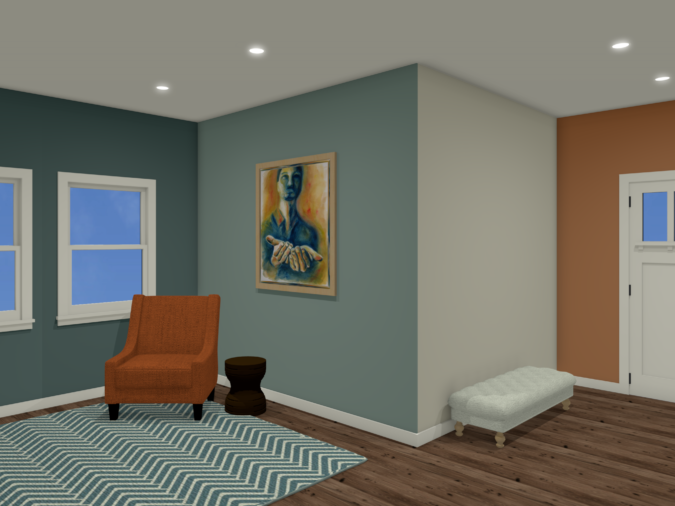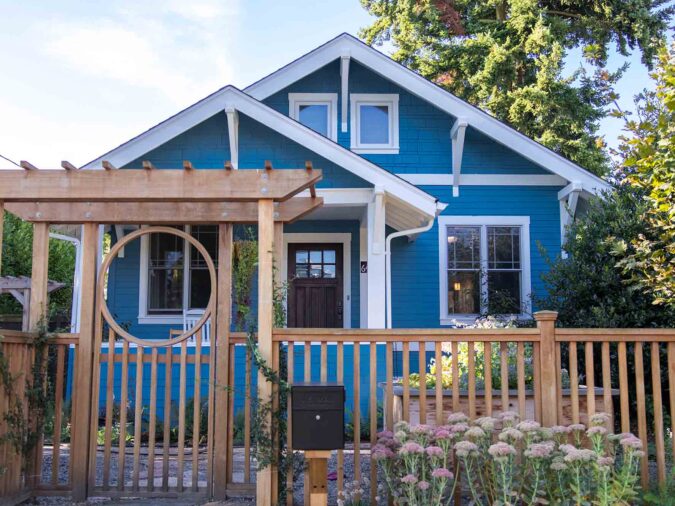How to Prepare for a Paint Color Consultation
How to Prepare for a Paint Color Consultation

Eager to get happy at home right now?
Get 10 tips for a happier home!
If you’re about to have an interior designer or color specialist come to your home for a paint color consultation, there are some things you should do ahead of time to make the most of your session! That prep work will vary based on what spaces we’re selecting colors for… feel free to read the whole post, or:
👉 Click Here if you’re choosing paint colors for the interior of a furnished house.
👉 Click Here if you’re choosing paint colors for the exterior of your home.
👉 Click Here to check out our general FAQs for color consultations.
Let’s dive in!
Choosing paint colors for a house you just bought or just remodeled?
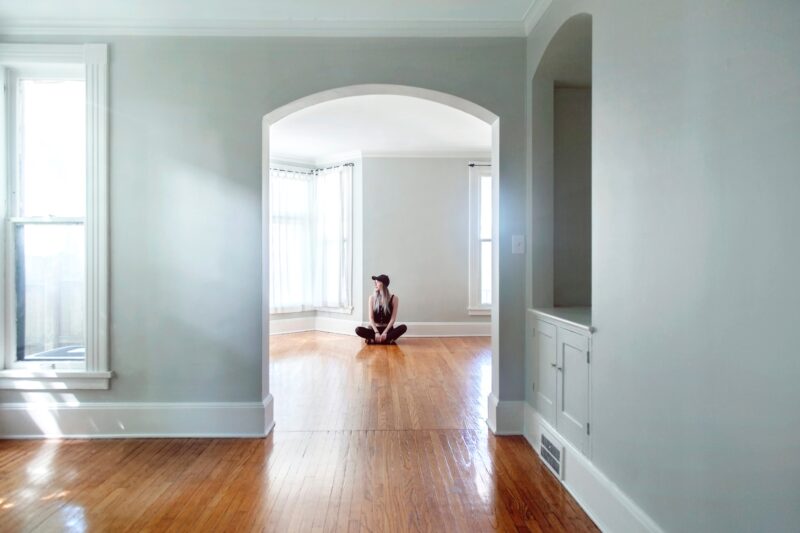
When a house is empty there are not environmental cues (aside from the color of installed surfaces like flooring, cabinets, counters, and tile) to tell your designer what you like. That makes your homework *that* much more important!
PLEASE do your homework! Empty houses are *The Hardest* for us as designers, because we have no environmental cues to use to identify what colors would work best for *your* home. If you haven’t moved in yet, then consider doing the following:
-
- Gather pics of furniture you already own (or plan to buy) that will be coming to the new space. Have them ready to show your designer on your phone or laptop. It’s even okay to print them out!
- Gather images of the kind of spaces you want to come home to. It’s much better to *show* us rooms you love than trying to describe them, since “blue” or “cozy” or “colorful” mean very different things to different people.
- Have a list of what is staying, and what is changing. When we look around your space we’ll be paying attention to the already-present elements like the flooring color, the kitchen and bathroom cabinets, counters, and backsplash tile, the fireplace tile, the trim color around your windows and doors, etc. If any of those elements will be *changing* be sure to say so (and, if possible, have samples of what they *will* be) – otherwise, we’re going to assume we need to work with what’s there.
- Consider whether you want one main neutral for the house, or if you want each room to be a unique color. Note that choosing multiple colors may take multiple sessions, depending on how quickly you make decisions, and how much preparation you’ve done (see 1, 2, and 3 above) to help us identify the best color choices for your new home. Also note that if you are having your home professionally painted, every additional color will add additional cost, since they have to budget time for cleaning and changing gear from color to color.
Choosing colors for a house you have lived in for a while?
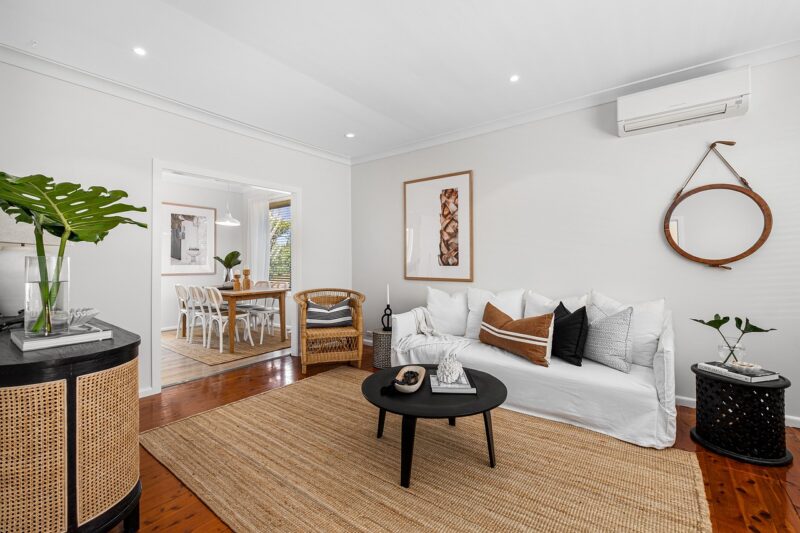
Note the red and orange colors in the flooring, and how the flooring is a different color in the adjoining dining room. Those existing elements will inform the colors we choose!
Lived-in houses are much easier for designers. We can often look around your home and instantly get a sense of what you like. But if you are looking for a dramatic change, or if you didn’t actually pick the colors and furnishings in your home, then do your homework:
-
- Have a list of what is staying, and what is changing. When we look around your space we’ll be paying attention both to the existing hard surfaces (like the flooring, kitchen & bath cabinets, counters, backsplash or fireplace tile…) as well as existing furnishings (like the sofa and rugs in a living room, or the headboard, bedside tables, and bedding in a bedroom, etc). If any of those elements will be *changing* be sure to say so (and, if possible, have samples of what they *will* be) – otherwise, we’re going to assume we need to work with and accent what’s there.
- Pull out or note items you want to feature in your home. A favorite piece of art or a rug you love can help us cue in on great colors much more quickly!
- Think about the mood or feeling you want for the room, and gather images of the kind of spaces you want to come home to. It’s much better to *show* us rooms you love than trying to describe them, since “blue” or “cozy” or “colorful” mean very different things to different people. This step is *extra* important if you are looking for a bold change from what you’ve got right now.
- Be prepared to tell us colors you’ve considered, and colors you dislike. Don’t worry, it won’t keep us from showing you colors outside of those preferences, but it gives us a sense of where you’re at in your thought process.
- Consider whether you want one main neutral for the house, or if you want each room to be a unique color. Note that choosing multiple colors may take multiple sessions, depending on how quickly you make decisions, and how much preparation you’ve done (see above) to help us identify the best color choices for your new home. Also note that if you are having your home professionally painted, every additional color will add additional cost, since they have to budget time for cleaning and changing gear from color to color.
Choosing colors for your home exterior?

Exterior colors are affected by the architecture of your home, existing elements like stone or brick, and your neighborhood’s vibe.
Again, PLEASE do your homework! Exterior paint color is both easier – and harder – than interior color. Easier because there are fewer “good” options, and harder because we know that you’re about to pay tens of thousands of dollars to have your home painted, AND you’re going to be living with this color for 20 or more years. It’s important to get it right! To help us get it right, here’s your homework:
-
- Gather images of home exteriors you would love to come home to, and try to choose homes that feature similar architectural details. A color might look amazing on a craftsman house with chunky trim, and terrible on a modern house with no trim, and vice versa. These images can come from online sources like houzz.com, real estate listings, or just from snapping pics around your neighborhood.
- Have a list of what is staying, and what is changing. When we look at your home the very first thing we’ll be doing is looking at the fixed elements like exposed brick or stonework, roof and gutter colors, natural wood doors, landscape elements like pavers and paths, etc. If any of those elements will be *changing* be sure to say so (and, if possible, have samples of what they *will* be) – otherwise, we’re going to assume we need to work with and accent what’s there.
- Let us know if these color choices are for resale, or just for you.
- Be prepared to list colors you’ve considered, and colors you dislike. We might show you colors outside of those preferences, but it gives us a sense of where you’re at in your thought process.
- Think about the mood or vibe you want the house to have. How do you want to feel when you come home? What should neighbors and guests say when they see your home?
- Think about your trim. Most folks these days like the look of white or off-white trim, but it’s not the only option! However, colorful trim *profoundly* impacts the choice of body color, so tell us early in the consult if you’re looking for a colorful trim rather than white or off-white.
- Think about “LRV.” LRV stands for “light reflective value” – darker colors have lower-numbered LRVs, and lighter homes have higher-numbered LRVs. Why should you care? Some paint companies won’t warranty super-dark colors, because super-dark colors are more likely to fade or fail (ie, bubble and peel) than medium or light colors. While one of our favorite painting companies, Phinney Ridge Painting, *will* paint your home in the trending navy and charcoal colors, they just can’t warranty the work like they can if the LRV is 20 or higher.
- Review your painter’s contract. In addition to checking to see if they have warranty limitations based on the LRV, the complexity of your color scheme may also already be set by your contract (since the complexity directly affects the quoted price of your paint job). If you’ve already agreed to a certain number of colors (for example, one for the siding, one for the trim, one for the doors, and one for the porch) then make sure to tell us! If you’ve haven’t chosen a painter yet, no worries! Just know that the more colors, the more money! 🤑
General FAQs and Notes:
- Should we choose colors on a gray or a sunny day?
- Honestly, it doesn’t matter – it’s going to need to look good in both situations! What’s more important is to choose the colors during strong daylight hours – dusk, dawn, and evening light will make it nearly impossible to evaluate the colors accurately.
- Should we have the lights on during an interior color consult?
- Not necessarily. Generally, we suggest looking at colors in the light in which you’ll usually see them. So if you always have the lights off or window treatments / blinds closed in your bedroom, maybe choose the colors with the shades open or lights on, but also be sure to look at them with the shades closed / lights off. If you have particularly warm / yellow or cool / blue light bulbs and plan to *change* them, consider changing them *ahead* of the session – the bulb color *will* change the colors you perceive!!
- What brand of colors do you use at Seriously Happy Homes?
- We use Benjamin Moore colors – we find they offer more colors than the other well-known brands. 🙂
- Can I match those colors to other brands?
- Of course! Note that if you’re going to have it matched at Home Depot, we recommend you insist that they scan the color rather than use the “recipe” they may have in the system – we’ve found this results in much more accurate matches. Know that not all matches are perfect (reds are particularly troublesome, and the colors in Benjamin Moore’s Affinity and Color Stories fans may be harder to match precisely) so be sure to have them paint a bit of the matched color onto your original color chip and dry it to check the color before leaving the store.
- What sheens do you recommend?
- Sometimes we break these rules, but the basics are: Eggshell for non-bath interior walls, flat for non-bath interior ceilings, satin for bathroom walls *and* ceilings, and satin or semi-gloss for trim and doors. For exteriors, low-sheen for siding, and semi-gloss for trim and doors. Painting brick? Please use a matte paint – brick just shouldn’t be shiny.
- Do you recommend testing the colors?
- This is a tough one. Testing is *not* helpful if you only paint a thin coat on the wall and it’s surrounded by the old color. The color won’t be accurate (because the old color is bleeding through the thin coat of paint) and your opinion of the color will be influenced by the surrounding (old) colors. So, if you *are* going to test, be sure to do a large section of wall (at least 2 feet by 2 feet) ideally next to trim or other elements that will be staying, and then cover the old color with your hand so you can judge only how the new colors will look together. Even so, the reflection of the color may still influence you (think of trying to look at a blue test patch in an all-yellow room – the test patch will look green-ish just from the reflected light). We prefer to get larger samples of the color from a company like Samplize.com so you have a true sense of the color, and you can move the sample around to different walls and look at it in different light. In the end, if testing sets your mind at ease, do it! Just make sure you’re looking at an accurate sample of the color!
I hope this helps you better-prepare for your color consultation! And if you’re actually *looking* for color-selection assistance we’d love to help! Just click on the Design Helpline service and we’ll get you on the calendar!
May your home always be happy!

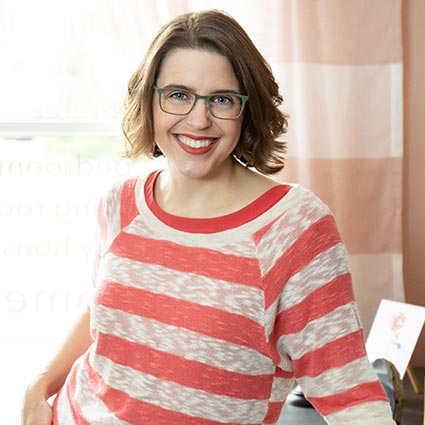
HI, I'M REBECCA WEST!
I’m an interior designer, author, podcaster, speaker, and coach to other designers. (Whew!) But I’m not your classic interior designer because, frankly, I don’t care if you buy a new sofa. I do care if your home supports your goals and feels like “you.” Remember, happy starts at home!
More From Seriously Happy Homes
Are you ready for a seriously happy home?
(Cue the confetti!)

Eager to get happy at home right now?

